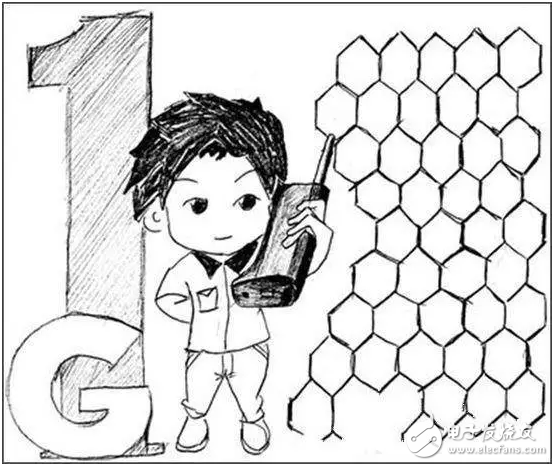The types of communication can be divided into: wireless communication in the form of wires, cables, optical cables, waveguides, nanomaterials, etc., wired communication and transmission media that are invisible and intangible (such as electromagnetic waves). Today we mainly talk about wireless communication.
1G: "Big Brother" is rampantIn 1986, the first mobile communication system was born in Chicago, USA, using analog signal transmission. The analog type represented the use of analog FM modulation in wireless transmission, converting the voice between 300Hz and 3400Hz to the high frequency carrier frequency MHz. . In addition, 1G can only be applied to general voice transmission, and the voice quality is low, the signal is unstable, and the coverage is not comprehensive enough.

The main system of 1G is AMPS, and there are also NMT and TACS. The system is widely used in Canada, South America, Australia and Asia Pacific. In the early 1980s, the mobile communication industry was still blank. Until the sixth session of Guangdong in 1987 The cellular mobile communication system was officially launched at the Games.
When the 1st generation mobile communication system was just established in China, many of us still took the big Motorola 8000X, which is commonly known as Big Brother (the average person can't afford it!). At that time, although there was no current mobile, China Unicom and telecommunications, there were points between the A network and the B network, and behind these two networks were Ericsson and Motorola, which dominated the analog era.
Analog communication systems have many drawbacks, such as serial number and hacking. In 1999, the A network and the B network were officially closed, and the 2G era also came to us.
1G network standard A network B network differenceDuring the 1G period, China's mobile phone public network consisted of the US Motorola mobile communication system and the Swedish Ericsson mobile communication system. After division, Motorola equipment uses the A-band, called the A system; Ericsson equipment uses the B-band, called the B system. The two systems A and B of mobile communication are the A and B networks that people often say.
2G: The era of Nokia's riseBy 1995, the new communication technology was mature, and under the guidance of Chunghwa Telecom, the company officially bid farewell to 1G and entered the era of 2G communication. From 1G to 2G, it is from analog modulation to digital modulation. In comparison, second-generation mobile communication has a high degree of confidentiality, and the capacity of the system is also increasing. At the same time, mobile phones can also access the Internet from this generation.
The quality of 2G sound is better, and the data transmission service is more than 1G. The data transmission speed is 9.6 - 14.4Kbit per second, and the earliest text message starts from here.

GSM was developed in Europe in 1990, in addition to TDMA, CDMA, PDC and iDEN. The first GSM phone that supports WAP is the Nokia 7110. Its appearance marks the beginning of the mobile Internet era, and the GSM network speed in that era was only 9.6KB/s.
The 2G era is also the beginning of competition for mobile communication standards, and GSM has emerged as the most widely adopted mobile communication system. As early as 1989, Europe adopted GSM as the unified standard for communication systems and officially commercialized it. At the same time, Nokia and Ericsson, which started in Europe, began to capture the US and Japanese markets. In just 10 years, Nokia became the world's largest mobile phone company.
2G mainstream several network standardsGSM : The Global System for Mobile CommunicaTIon is the most widely used mobile phone standard. The biggest difference from previous standards is that its signaling and voice channels are digital. GSM is an open standard currently developed by 3GPP.
TDMA : Time division multiple access (TIme Division MulTIple Access), which divides time into periodic frames, and each frame is divided into several time slots to send signals to the base station. Under the condition of satisfying timing and synchronization, the base station The signals of the mobile terminals can be received in each time slot without confusion. At the same time, the signals sent by the base station to the plurality of mobile terminals are arranged in a predetermined time slot for transmission, and each mobile terminal can receive the signal sent to it in the combined signal as long as it is received in the designated time slot. And received it.
CDMA : Code Division MulTIple Access is a new and mature wireless communication technology developed on the branch of digital technology-spread spectrum communication technology. The principle of CDMA technology is based on spread spectrum technology, which is to transmit a certain signal bandwidth information data, and is modulated by a high-speed pseudo-random code whose bandwidth is much larger than the signal bandwidth, so that the bandwidth of the original data signal is expanded, and then modulated by carrier. Send it out. The receiving end uses the identical pseudo-random code to perform correlation processing with the received bandwidth signal, and the narrowband signal of the original information data is despreaded to realize information communication.
Monitor Stand For Computer Screens
Shenzhen ChengRong Technology Co.,Ltd. , https://www.laptopstandsupplier.com